
The Ponte Vecchio is a medieval stone closed-spandrel segmental arch bridge over the Arno, in Florence, Italy. The only bridge in Florence spared from destruction during World War II, it is noted for the shops built along it; building shops on such bridges was once a common practice. Butchers, tanners, and farmers initially occupied the shops; the present tenants are jewellers, art dealers, and souvenir sellers. The Ponte Vecchio's two neighbouring bridges are the Ponte Santa Trinita and the Ponte alle Grazie.
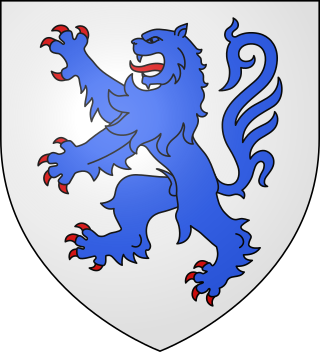
The Acciaioli family, also spelled Acciaiuoli, Accioly, Acciajuoli or Acioli was an important Italian noble family from Florence, whose members were the ruling Dukes of Athens.
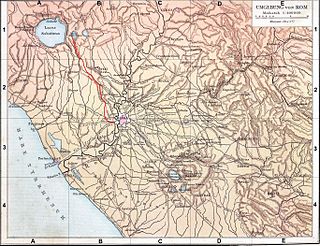
The Aniene, formerly known as the Teverone, is a 99-kilometer (62 mi) river in Lazio, Italy. It originates in the Apennines at Trevi nel Lazio and flows westward past Subiaco, Vicovaro, and Tivoli to join the Tiber in northern Rome. It formed the principal valley east of ancient Rome and became an important water source as the city's population expanded. The falls at Tivoli were noted for their beauty. Historic bridges across the river include the Ponte Nomentano, Ponte Mammolo, Ponte Salario, and Ponte di San Francesco, all of which were originally fortified with towers.

Ponte Amerigo Vespucci is a bridge over the Arno River in Florence, Italy and named after Florence-born explorer Amerigo Vespucci. It joins the Lungarno Amerigo Vespucci to the Lungarno Soderini. To the east is the Ponte alla Carraia.

The Vasari Corridor is an elevated enclosed passageway in Florence, central Italy, connecting the Palazzo Vecchio with the Palazzo Pitti. Beginning on the south side of the Palazzo Vecchio, it joins the Uffizi Gallery and leaves on its south side, crossing the Lungarno dei Archibusieri, then following the north bank of the River Arno until it crosses the river at Ponte Vecchio. At the time of construction, the corridor had to be built around the Torre dei Mannelli, using brackets, because the tower's owners refused to alter it. The corridor conceals part of the façade of the Church of Santa Felicità. It then snakes its way over rows of houses in the Oltrarno district, becoming narrower, to finally join the Palazzo Pitti. The corridor's full length is approximately one kilometre.

Santa Cristina is a Neoclassical-style, Roman Catholic church in Pisa, region of Tuscany, Italy. It is located on the Lungarno Gambacorti.
Piazzale Michelangelo is a square with a panoramic view of Florence, Italy, located in the Oltrarno district.

The Villa Torrigiani is located in the hamlet of Camigliano, a town in Capannori (Lucca). It is a historical villa, dating from the second half of the sixteenth century.
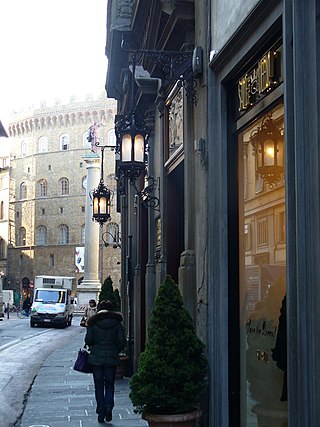
Via de' Tornabuoni, or Via Tornabuoni, is a street at the center of Florence, Italy, that goes from Antinori square to Ponte Santa Trinita, across Santa Trinita square, distinguished by the presence of fashion boutiques.
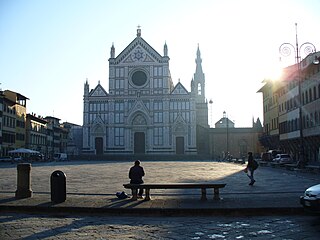
The Florence Marathon is an annual full-length marathon race held in late November in Florence, Italy, since 1984.

Dante and Beatrice is a painting dated 1883 by the artist Henry Holiday that is on display in the Walker Art Gallery, in Liverpool, England. It is considered to be Holiday's most important painting. It is executed in oil on canvas, measuring 142.2 centimetres (56 in) by 203.2 centimetres (80 in) and was purchased by the gallery in 1884.

The Cittadella Nuova, now called the Giardino di Scotto or Giardino Scotto is an old fortress in Pisa.

The Palazzo Nasi, also known as the Palazzo Torrigiani or Palazzo Scarlatti, is a palace located at Piazza de' Mozzi 4, down the street where the Ponte alle Grazie enters the Oltrarno, in Florence, Tuscany, Italy. Another Palazzo Torrigiani Del Nero, with a Mannerist or late-Renaissance-style facade stands closer to the river. Both palaces also once belonged to the Nasi. The palace is a few steps from the Palazzo Mozzi.
The Palazzo Tempi, also known as Palazzo Vettori or Bargagli Petrucci, is a palace located along the Arno river at the narrow Piazza Santa Maria Soprarno 1, corner with Via de' Bardi and Costa dei Magnoli in the Oltrarno section of Florence, Tuscany, Italy. The palace is across the river from the Galleria of the Uffizi, and a block east of the Ponte Vecchio. The Via de' Bardi originates in an arch under the building.
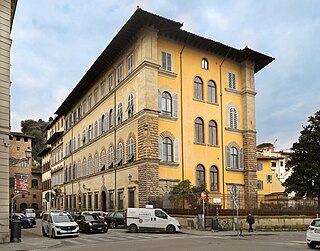
The Palazzo Torrigiani Del Nero is a Renaissance-style palace located at Piazza de' Mozzi 5, down the street where the Ponte alle Grazie enters the Oltrarno in Florence, Tuscany, Italy. Another Palazzo Torrigiani stands alongside, the smaller Palazzo Nasi. Both palaces also once belonged to the Nasi.

The Palazzo Bartolini-Torrigiani is a palace located between Via Porta Rossa and Via delle Terme, in the city block just west of Piazza Santa Trinita that includes the Palazzo Bartolini Salimbeni, in the center of the city of Florence, region of Tuscany, Italy. This portion of the block includes the medieval Torre dei Monaldi, also known as della Rognosa, rising along Via Porta Rossa.

Palazzo Serristori is a Renaissance style palace located between Piazza Demidoff and the Lungarno Serristori in Oltrarno, in the neighborhood of San Niccolò of Florence, region of Tuscany, Italy.
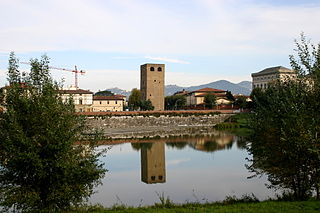
The Torre della Zecca is a tower in the city walls of Florence, closing the city off from the river Arno to the east and thus known as a "torre terminale". It is now isolated in the middle of a junction on the viali di Circonvallazione in piazza Piave, near the lungarno della Zecca Vecchia.

Piazza Piave is a square on the viali di Circonvallazione in Florence, Italy. It marks the eastern boundary of the historic city centre on the north bank of the river Arno. At its centre is the Torre della Zecca Vecchia. It marks the junction between five traffic arteries - the Lungarno della Zecca Vecchia, the Lungarno Pecori Giraldi, the viale della Giovine Italia, via dei Malcontenti and via Tripoli. Inside the city wall, at the junction between via Tripoli and via dei Malcontenti, the square widens - this space is recorded on the carta del Buonsignori (1565) as the "Sepolture dei Giudei" or Jewish Cemetery. It was known as the Piazza della Zecca Vecchia until 1919, when it was renamed in honour of the Battle of Piave River.
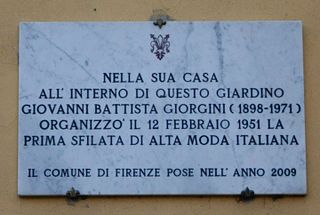
Giovanni Battista Giorgini, nicknamed Bista, was an Italian entrepreneur and member of the Giorgini family.


















